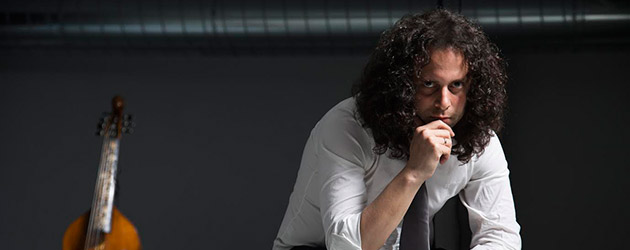Silvia Cruz Lapeña.
Photos & video: La Bienal
The interpreter of historic music, returns to flamenco via the singer from Huelva to brighten up the daytime at the Bienal de Sevilla
No better place than a converted church to offer a different kind of flamenco. Rocío Márquez and Fahmi Alqhai, singer and musician, presented their work in the daytime in what had been a baroque church, to perform «Diálogos de Viejos y Nuevos Sones». The mixure of historic music with flamenco has yielded such fine fruit as “Cant dels Ocells” in flamenco format. «That's one of the ways in which I was marked after having worked ten years with Jordi Savall. I have several versions of the Pau Casals piece, and I wanted to present one in the voice of Rocío» explains Alqhai to Deflamenco. The result is almost a lullaby, a cradle song to soften all the rules.
Fahmi Alqhai is a Seville man from Syria…or vice versa, director of the Festival de Música Antigua de Sevilla (FeMÁS), and interpreter of the viola da gamba, which is omnipresent in Renaissance and Baroque music. «It is an instrument with great possibilities, although I have to admit it's very difficult to play siguiriyas on it». Along with Rocío Márquez, he was in charge of bringing life to the daytime at the Bienal de Sevilla at San Luis de los Franceses, a church which had been closed for ten years due to reforms, and a place that brought Fahmi good memories. «This is where I debuted with my project Accademia del Piacere over a decade ago». With that group I worked with another singer, Arcángel, who explored the roots of flamenco and colonial music in a show that has traveled half-way round the world, and which will be presented in Barcelona on October 8th at the Festival Connexions. «That's a bigger project, it involved eleven musicians. What I do with Rocío is more intimate, but it's the fruit of a personal and artistic quest which has gone on for nine months».
Alqhai says that to come to the Bienal, it would have been easier to take an existing score and make it sound like the 17th or 18th century. «But that's what I do in my concerts of historic music». For the most important flamenco event in the country, he wanted to take chances and try something else. And he called on Márquez, with whom he shared the creation of «Diálogos de Viejos y Nuevos Sones», which will be repeated on September 18th and 24th, and October 2nd. The result has an impact because it includes pieces such as “Si dolce è’l tormento” of Claudio Monteverdi, and the music of guitarists like Paco de Lucía and Miguel Ángel Cortés; the version del “Cant dels ocells” with lyrics by the Seville poet Manuel García and fandangos de Alosno with 17th century reminiscences.
No fear of critics
But «Diálogos…» is not a mixture. What the duo proposes is a brotherhood, and to achieve it, both delved into oral tradition and manuscripts, they look to within their own beings, which is why Andalusia, American folklore, 17th century chaconnes and songs in ostinatos are all heard. To that amalgam, Rocío Márquez added her musical knowledge, and one of the best-tuned and beautiful voices of the current flamenco panorama. «It's been a pleasure, because she's a hard worker, she likes to collaborate, and tries to get into a diversity of projects. She respects music, but isn't afraid of it».
When he says «fear», Fahmi is partly thinking of the critics. «The flamencos have been more benevolent, but they also put us through the wringer when we worked with Arcángel. I'm hurt by critics with an open mind, but the watch-dogs of tradition make me laugh». He finds the current music panorama less amusing, the conditions performers work in, and he blames the politicians and promoters. «But also some of the artists who agree to work at any price». He feels fortunate and well-rewarded; he's been a soloist since 1998, director of the FeMÁS since 2009, he has his own recording company and is considered one of the best on the viola da gamba, an instrument to which he is determined to give a contemporary sound.
For the moment, enjoy «Diálogos…», a project which has also taken on Agustín Diassera, one of the most talented percussionists in flamenco, long sought-after by other genres. He doesn't apply the fury used by others, he is contained, and that softness perfectly complements the viola da gamba (an instrument which is not plucked, but rubbed; it is held between the legs, but not touching the floor), and the very special voice of Márquez. The result is dynamite, a delicate and explosive conjunction in which the venue, a church in name only, becomes all the more powerful.
